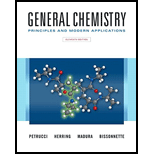
(a)
Interpretation:
The nucleophile, electrophile and the leaving group in the following substitution reaction are to be determined.
Concept introduction:
Substitution reactions are the
Nucleophiles are the electron-rich species that donate an electron pair in the reaction and electrophiles are the electron-deficient and accept an electron pair in the reaction. The leaving group is a part of the molecule that departs or leaves with a pair of electrons in the heterolytic cleavage.
A substitution reaction favors product formation if a weaker base is formed relative to the nucleophile and vice-versa.
(b)
Interpretation:
The nucleophile, electrophile and the leaving group in the following substitution reaction are to be determined.
Concept introduction:
Substitution reactions are the chemical reactions in which an atom, ion or group in one molecule is replaced by the other. These are also known as the single displacement or single substitution reactions.
Nucleophiles are the electron-rich species that donate an electron pair in the reaction and electrophiles are the electron-deficient and accept an electron pair in the reaction. The leaving group is a part of the molecule that departs or leaves with a pair of electrons in the heterolytic cleavage.
A substitution reaction favors product formation if a weaker base is formed relative to the nucleophile and vice-versa.
Want to see the full answer?
Check out a sample textbook solution
Chapter 27 Solutions
Generl Chem Looself&mod Mst/et&stdy Crd Pkg, 11/e
- Halogenation reaction of hydrocarbons can occur via which mechanism? a Radical substitution b Electrophilic addition c Electrophilic substitution d All of the abovearrow_forwardPredict the structure of the reactant or product in the following reactionsarrow_forwardWhich of the following alkene reactions has a charged, cyclic reactive intermediate? Hydroboration Hydration Hydrohalogenation Halogenation Catalytic hydrogenationarrow_forward
- Only one of the chlorine atoms in the molecule, 3,4-dichloronitrobenzene, will undergo nucleophilic substitution. Indicate which position will react and provide the expected product for the given reaction using reaction intermediates (resonance structures).arrow_forwardDetermining the Mechanism and Stereochemistry in Nucleophilic Substitution Determine the mechanism of nucleophilic substitution for each reaction and draw the products, including stereochemistry.arrow_forwardExplain Allylic Carbocations in Biological Reactions ?arrow_forward
- Predict the products of the following reactions. benzyl bromide + sodium cyanidearrow_forwardFor each reaction, decide whether substitution or elimination (or both) is possible, andpredict the products you expect. Label the major products. 1@bromo@1@methylcyclohexane + triethylamine (Et3N≠)arrow_forwardWhat are the differences between electrophilic reactions and nucleophilic reactions?arrow_forward
- Nitration of an aromatic ring involves an electrophilic substitution reaction. Draw the structure of the electrophile that is attacked by the aromatic ring and the intermediate formed after attachment of the electrophile to the ring. Be sure to show formal charges.arrow_forwardIn free-radical substitution reaction of alkanes with halogens under uv light, the photolytic breaking of the halogen is the rate determining step. the formation of alkylradical is the rate determining step. the formation of halogen radical is the rate determining step. the abstraction of hydrogen from alkane by the halogen radical is the rate determining steparrow_forwardSpecify the reaction conditions to favour the indicated elimination mechanism. a. Strong base, such as hydroxide, an alkoxide, or equivalent b. Water or alcohol or equivalent weak base with heat c. Weak acid, such as formic acid, or equivalent d. Strong base, such as hydroxide, an alkoxide, or equivalentarrow_forward
- Chemistry: Matter and ChangeChemistryISBN:9780078746376Author:Dinah Zike, Laurel Dingrando, Nicholas Hainen, Cheryl WistromPublisher:Glencoe/McGraw-Hill School Pub Co




